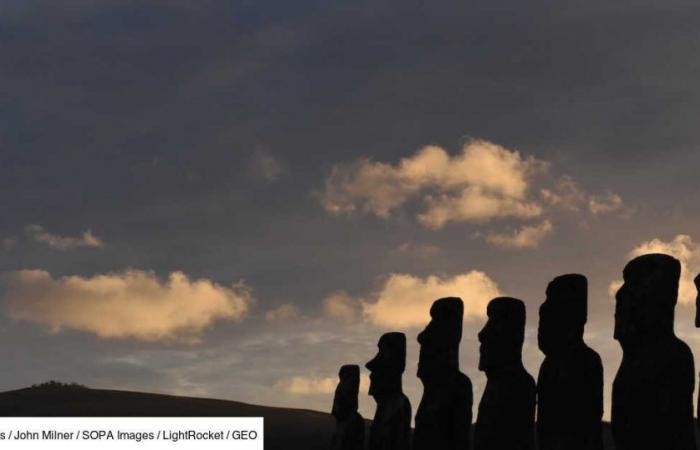One theory has long presented Easter Island (Rapa Nui) as the perfect example of humans compromising their survival by destroying their environment. It suggests that the isolated South Pacific island, located about 3,700 kilometers west of the coast of Chile, was once populated by a large population that collapsed due to “ecocide”; she would have lived beyond her means and exhausted the resources of the place, in particular, to move her more than a thousand basalt statues (moai) on their stone terraces (ahu).
A new study, published in Science Advances on June 21, 2024, however refutes this idea put forward by geographer Jared Diamond (Collapse, 2004). Using artificial intelligence to analyze satellite data from “stone gardens,” the islanders’ form of subsistence agriculture, researchers determined that the island “probably never housed many more than the approximately 3,000 people encountered by European explorers in 1722”writes in The Conversation Carl Lipo, professor of anthropology at Binghamton and New York State universities (United States) and co-author of this recent research.
The rest under this advertisement
Nature takes its time…
like this ad!
Nature takes its time…
like this ad!
Discovering Easter Island through photos from the GEO Community
“Stone gardens” to meet needs
The soils of Rapa Nui have never been very fertile, depleted of essential nutrients (potassium, phosphorus, nitrogen) due to the volcanic nature of the island and its oceanic salt spray. Constraints to which its first inhabitants had to adapt.
The archaeological sites identified on its lands show that they developed different types of agriculture, some of which remarkably involved volcanic stones: “stone gardens” or “pavement gardens”. Used by the Maoris of New Zealand, indigenous peoples of the American southwest and even farmers in the Netherlands, the technique consists of breaking parent rock into very small pieces and mixing them with the soil to improve it. nutrient levels and prevent erosion.
The rest under this advertisement
Nature takes its time…
like this ad!
In the ancient gardens of Rapa Nui taro and purple yam were grown, but above all, many varieties of sweet potatoes. “[Ces] extensive cultivation plots […] are found throughout the island and would have provided a crucial food source supplemented by marine resources”, explains Carl Lipo. The true extent of the surface they covered, however, remained a mystery for a long time. The first Europeans to arrive there estimated that they took up 10% of the island. Other more recent studies have claimed that they could have fed up to 16,000 people.
A company of 3,000 people “at its peak”
The archaeologists’ work revealed that areas identified as stone gardens were not in reality. New excavations were therefore carried out, coupled with short-wave infrared satellite images, useful for distinguishing materials that appear identical to the naked eye. The development of machine learning models (machine learning), also allowed scientists to detect the most subtle differences “repeatedly and systematically”so that they were able “examine almost the entire island quickly without spending years doing field mapping”it is specified.
The rest under this advertisement
Nature takes its time…
like this ad!
Nature takes its time…
like this ad!
These analyzes significantly reduced the area that could be associated with “stone gardens”, from a range of 4.3 to 21.1 square kilometers to 0.76 square kilometers – out of the 164 square kilometers of the island. From this revised basis, the authors calculated that this form of cultivation would have only supported a population of around 3,900 people at most.
“Thus, contrary to the ecocide narrative, the population present when the Europeans arrived was not the remnants of Rapa Nui society, but likely the society at its peak, living at sustainable levels on the island “concludes with the Guardian Dylan Davis, postdoctoral researcher at the Climate School at Columbia University (United States) and co-author of the study.
The rest under this advertisement
Nature takes its time…
like this ad!
Warning or source of inspiration?
It must be said that the first Europeans were surprised – and that is an understatement – by the colossal figures built at Rapa Nui: its moai can reach the height of a three-story building and weigh up to 70 tons. It was therefore quickly assumed that tens of thousands of individuals must have been involved in the carving and transportation of such statues.
Thus was born the “collapse story”, arguing that such work would not have been sustainable and would have led to food shortages, famines, wars and even cannibalism, ultimately explaining the small population encountered by Europeans in the Eighteenth century.
This theory has remained anchored in academic literature, and is not without consequences. “Despite archaeological evidence to the contrary, it is not uncommon, for example, for environmentalists to use Rapa Nui as a case study of so-called Malthusian demographies [selon les théories de Thomas Malthus, ndlr] where the population is believed to have reached a massive peak which momentarily overwhelmed the island’s resources and triggered an ecological catastrophe”, regrets Carl Lipo. For at least a decade, however, research contesting this idea of ecocide due to population growth and poor landscape management has been increasing.
The rest under this advertisement
Nature takes its time…
like this ad!
Nature takes its time…
like this ad!
The authors of the study, however, emphasize the importance of being concerned about the potential exploitation of natural resources. “Our growing understanding of the island has crucial implications for the future.”develops the anthropologist. “By learning how to thrive in a limited environment, society can adopt the strategies used by people of the past”, like the ingenious “stone gardens” developed by the islanders. He adds :
Ultimately, the story of Rapa Nui is not a cautionary tale, but a source of inspiration that could be essential for the future of humanity.






